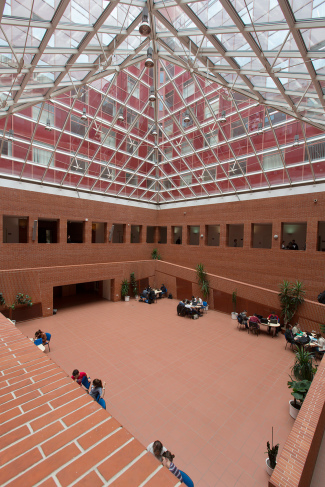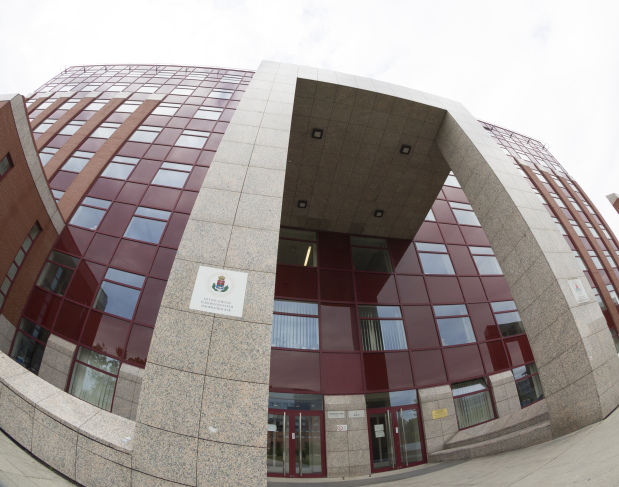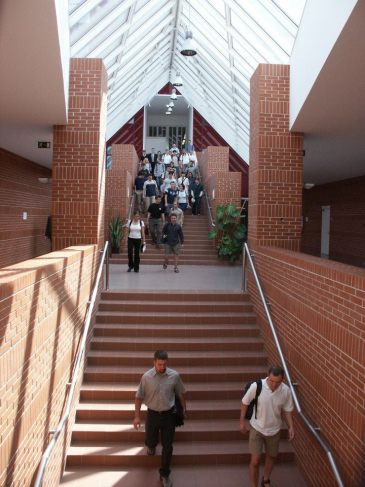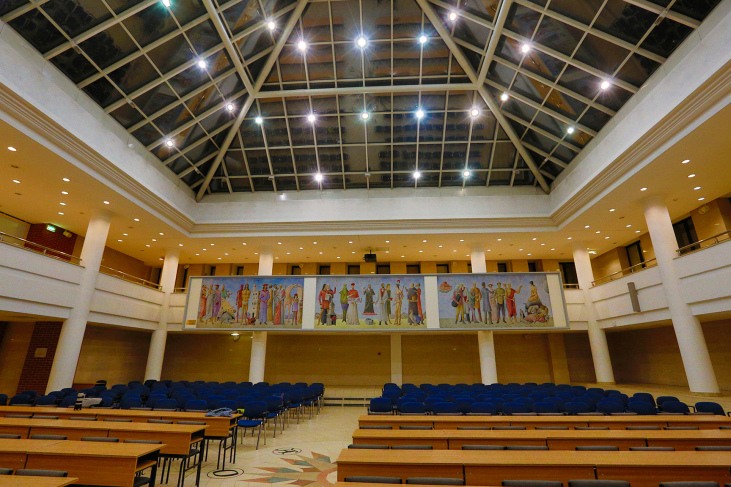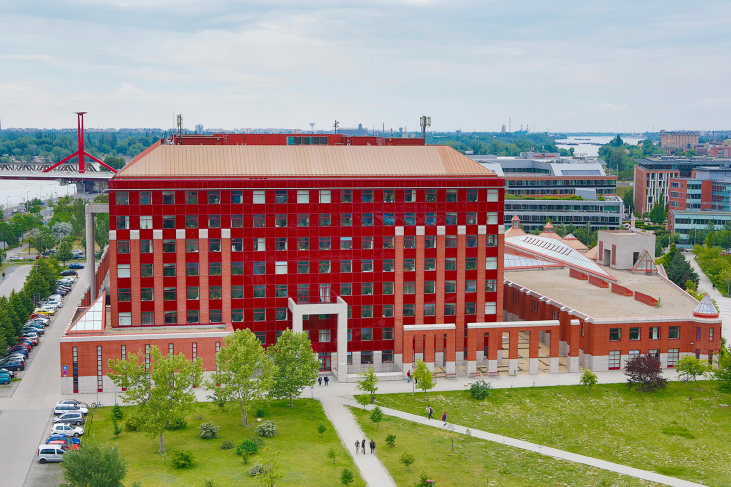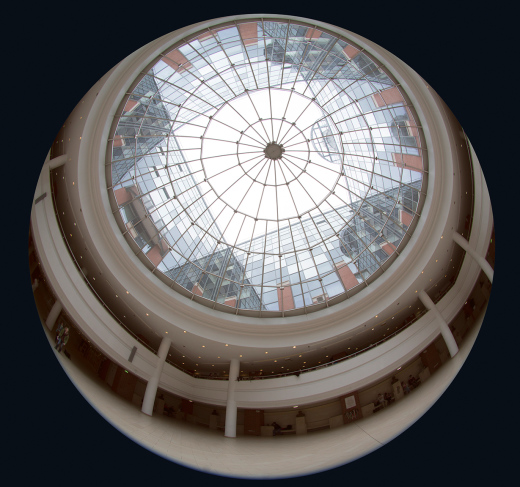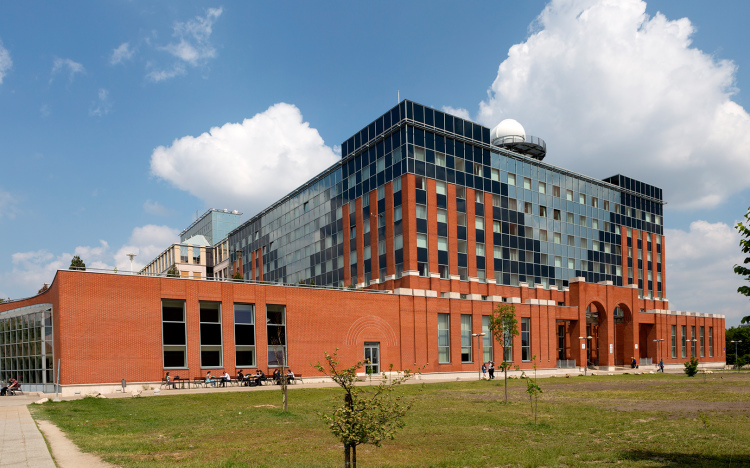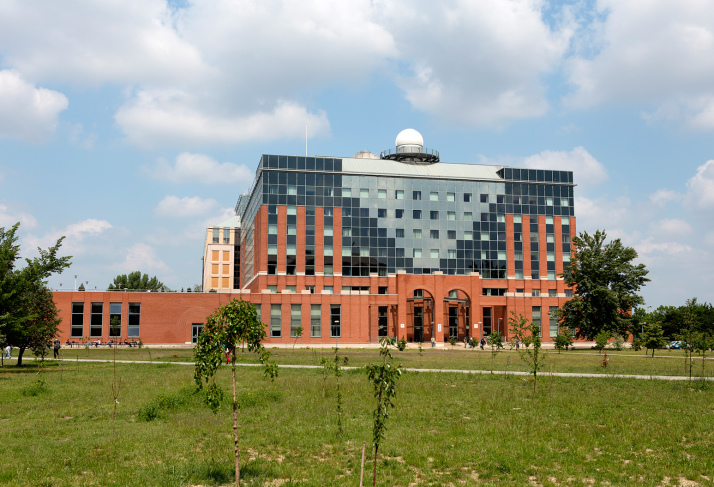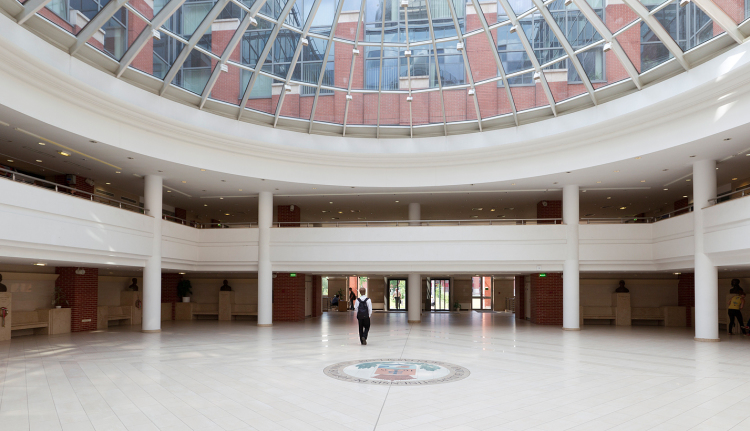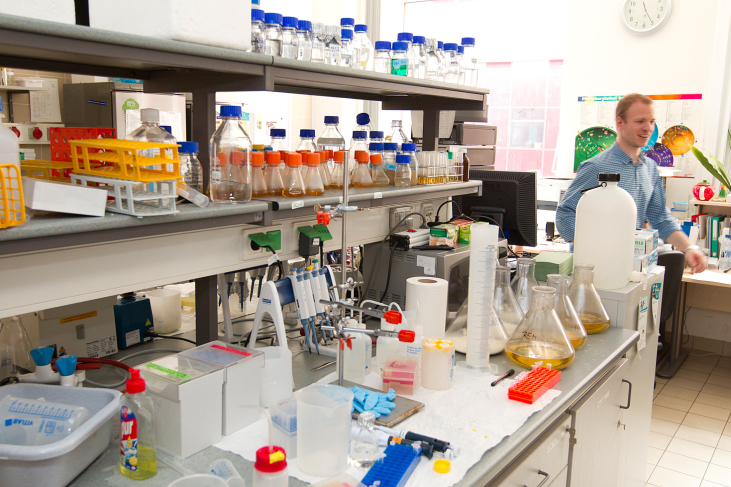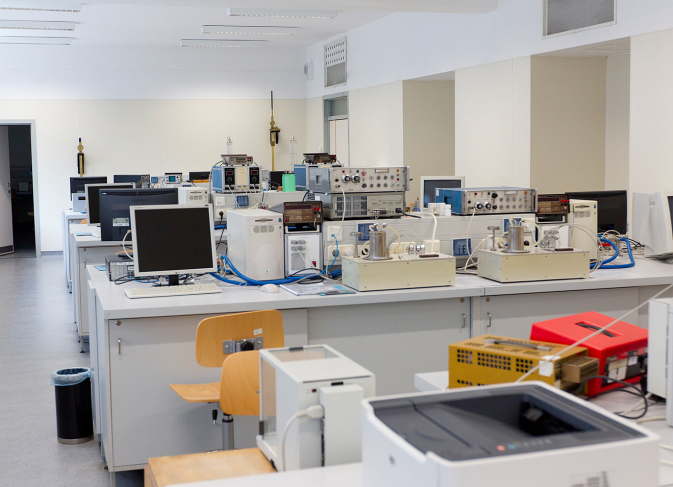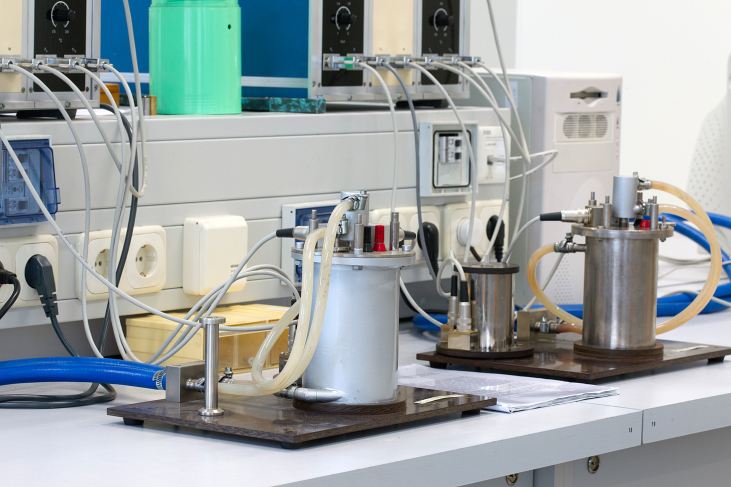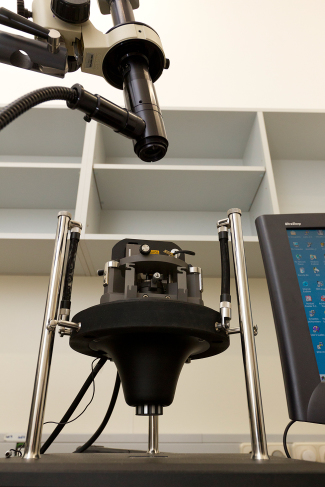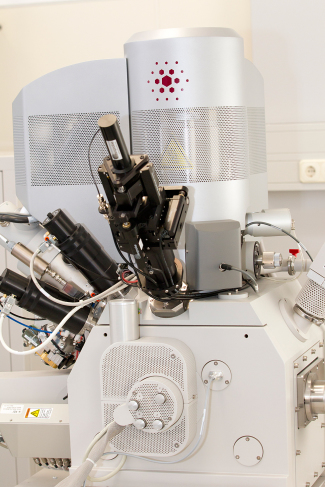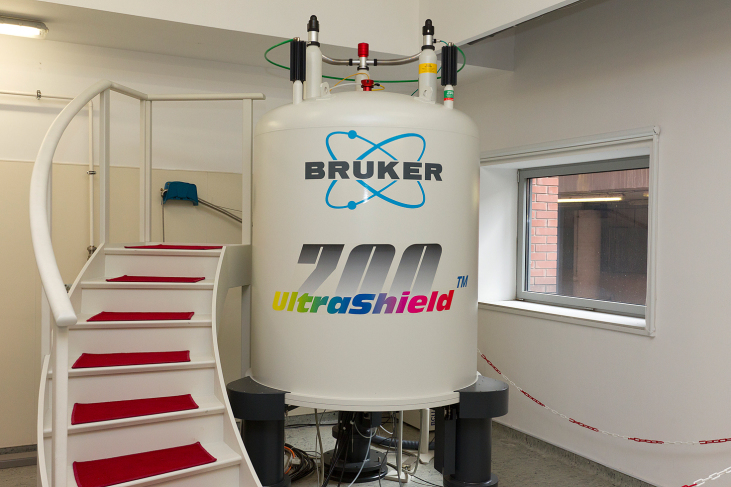Chemistry MSc

Occupied Palestinian Territory

India
Chemistry MSc
Chemist
Degree program
Master
FNYF/100-3/2016
Institute of Chemistry
English
4 semesters (2 years)
120
1
40
The goal of this program is to give an advanced level knowledge in the major fields of analytical, inorganic, organic and physical chemistry. The program involves obligatory lectures and laboratory practices in all four fields. (Semi)elective courses offer the opportunity of tuning the program content according to interest.
This program is recommended to applicants who are willing to organize their own course schedule. A good background in BSc level chemistry enables the student to focus on his/her topic of interest right from the beginning. Those who are less knowledgeable in basic chemistry must complete resuming courses.
In the frame of the program research experience can be gained in at least one main discipline of chemistry. Skill can be acquired in developing and applying ideas within a research project.
Specializations: Academic specializations can be obtained if the number of the specialized courses sums up to 26 credits in different grouping of the courses.
The strength of the program is the combination of solid background knowledge with research activities performed at internationally recognized laboratories of the Institute of Chemistry.
Find the updated version of the curriculum on the webpage of the faculty.
Obligatory major courses
Transmission electronmicroscopy, gas chromatography / mass spectrometry, ion chromatography, electrophoresis, ultra micro electrodes, scanning electronmicroscopy, electron beam micro-analysis.
The course intends to provide students with definitions and basic principles of organometallic chemistry, its history and its position in chemistry, the main trends in research and applications. Further topics as the nature of the metal-carbon bond, the basic groups of compounds, stability and thermochemistry, preparation as well as characteristic reactions are discussed. Typical examples concerning structure and bonding, as well as industrial applications are shown.
The basic concepts of the most important methods of structure determination and the scope and limitations of their application in inorganic chemistry are covered. Particular emphasis is put on the relation of structure and reactivity of simple and more complex inorganic compounds and on the recognition of synthetic possibilities estimated from structural considerations taking into account eg. the principle of isolobality, with special regard to borane-, carborane-, metallocarborane- and metal clusters. The application of qualitative MO theory of chemical bonding is demonstrated to interpret the structure of more complex compounds.
In this practical course, students get experience in the field of advanced preparative and manipulation techniques like semi-micro syntheses in vacuum and inert atmosphere, the Schlenk technique, electro- and photochemical preparations, microwave assisted reactions, chemical vapour deposition. The studied chemical systems include – among others – transition metal catalysts, clusters, organometallic reagents and precursors.
Classification and rationalization of the pericyclic reactions on the basis of qualitative molecular orbital theory. Electrocyclizations with participation of 2, 4, and 6 electrons, the rule of conservation of symmetry. Possibilities for 2+2 cycloadditions. Reaction of carbenes with olefins. Radical 2+2 cycloadditions. Regioselectivity and electron demand in Diels-Alder reactions. Intramolecular Diels-Alder reactions. Rationalizations and practical use of sigmatropic rearrangements. Stereochemistry of [3+3] sigmatropic rearrangements. Higher sigmatropic rearrangements. The theory of photochemistry. General principles of ring closure reactions, synthetic applications. Baldwin-rules and their interpretation.
Small scale syntheses; Organic syntheses using advanced methods in 100 – 500g scale; Scale up in laboratory; Problems of industrial scale up; Connection between research, industry and business: feasibility study based on a multistep synthesis carried out during the course.
Chapters not or only superficially covered by the Physical chemistry BSc courses 1-2. (e.g. Axiomatic thermodynamics, nonequilibrium thermodynamics and transport processes, thermodynamics for engineers, basics of hydrodynamics and rheology, introduction to solid state physics, liquid crystals, quasi-crystals, glasses, introduction to the theory of chaos and fractals, information theory.
Professional courses: Analytical Chemistry
Major objectives: to understand and apply the knowledge presented in the course in solving various problems in the atmospheric and water environments, and to help students to integrate the environmental approaches into other branches of natural science. Topics covered: General process of environmental pollution, imission, and transmission, classification of the pollution sources of and main pollutants in the air and waters, hazard represented by the main pollutants. Sampling methods for gases and aerosol particles. Laboratory and on-line measuring methods for atmospheric gasses and aerosols. International and national legislations. Methods of reducing air pollution. Water management. Water pollution, main polluting species. Sampling and qualification tests of surface-, ground-
...
Review of the basiscs of nuclear chemistry. Nuclear methods in chemical analysis: conventional and prompt gamma neutron activation analysis, gamma spectroscopy, alpha and beta backscattering, XRF, PIXE. Nuclear methods in structural research: Mössbauer-spectroscopy, positron annihilation spectroscopy. Electron spectroscopies. Radiation chemistry. Hot-atom chemistry. Application of radioisotopes in industry. Stable isotopes in nature, application, isotope enrichment methods. Nuclear reactors and energy production. Applications in biochemistry, biology and medicine. Radiation protection.
Definitions. Control of contamination and loss. Flow injection analysis,(FIA). Hydride generation. Liquid-liquid extraction. Precipitation and coprecipitation. Sorbent extraction: Sorption of metal-chelates on nonpolar sorbents and retention of metal ions by chelating agent adsorbed on a support. Enrichment by ion-exchange, chelating exchange. Hyphenated techniques: Joint separation techniques (HPLC, GC, capillary GC, capillary electrophoresis – CE) with Atomspectrometric detectors (ICP-AES, ICP-MS, GFAAS, FAAS etc.). Field flow fractionation (FFF): separation and preconcentration. Competency: critical approach of publications; design, realization and evaluation of a preconcentration procedure.
The objective of the Food Analysis laboratory practices is to introduce students to the basic Analytical chemistry methods used in Food Analysis (i.e., titrimetry with instrumental end point indication, UV-Vis spectrophotometry, thin layer/liquid/ion chromatography) for food sensory evaluation, determination of major (i.e., Krebs cycle acids, alcohol, carbohydrates, unsaturated fatty acids) and minor food (i.e., trace elements, halides, food preservatives) components in basic foodstuffs and commodities such as: egg, eggshell, milk, bread, vegetal oils, curing salt as well as hedonic products such as chocolate, wine, candies, chewing gum, fruit juices.
Weekly schedule:
- Safety and fire instructions in the laboratory.
- Food Sensory Evaluation: distinguishing between the four
...
The lecture aims at widening the knowledge of the students about gas and fluid chromatographic techniques. Sample preparation, special injection and detection techniques and the necessity of coherence in their coupling will be demonstrated through applications in environmental, food, pharmaceutical and forensic analytics.
- The aim of drug analysis
- The steps of drug research
- The role of analytical chemistry in drug research in drug production in drug formulation in drug development in the efficacy of drog therapy in the safety of drog therapy in the economy of production of drugs…
- Methodological aspects (determination possibilities): „classical” (chemical) methods (titrimetry, in aqueous and nonaqueous medium) instrumental methods electrochemistry (potentiometry, conductometry…) spectroscopy (UV-Vis, Fluorescence, MS…) chromatography (TLC, HPLC, EC…) thermal analysis (DTG, DTA…) hyphenated techniques (HPLC-NMR, ICP-MS…) X-ray methods immun analytical methods…
- Quality control of drugs - Drug stability issues
- Drug impurity profiling - The role of pharmacopoeias (EU,
...
The elective Food Analysis laboratory practice gives an insight into food analysis methods from titrations with chemical and instrumental (potentiometric, conductometric) indication to modern analytical techniques (atomic fluorescence, flame photometry, spectrophotometry, high performance liquid chromatography, ion chromatography, etc.). The analyzed matrices: wine, bread, egg and dairy products (milk, margarine), chewing gum, sweets (hard candy, plain chocolate), flour, oil, food supplements and preservatives (multivitamin tablets, pickle salt), soft drinks (Coke, fruit juices) and fresh fruits. Target compounds: acids, alcohol, lipids, carbohydrates, macro and micro nutrients. Moreover, from food sensory evaluation, identification of red wine flavors as well as that of
...
Historical review about quality contol and quality assurance systems. Comparison of ISO 9000 and ISO 17025 systems, quality cycle in case of testing laboratory. Quality management, quality audit. Characteristics of an analytical method, sampling and evaluation procedures. Standard operation procedures, validation. Examples from industrial and research laboratories. Equipment maintenance, calibration, training. Authorized personnel descriptors. Examples of proper use and preparation procedures of certified reference materials.
Fundamentals of emission and absorption spectra of atoms, atom and ion sources used in microanalysis, characteristics of X-ray fluorescence, total-reflection and its consequences, detection of ions from an ICP by mass spectrometry. Scanning electron microscopy, specimen preparation, coating procedures, interpretation of X-ray micrographs, elemental mapping. Comparison of analytical features of selected methods.
Ionselective electrodes, potentiometry, determination of pH. Sensors, biosensors.Voltammetric techniques: cyclic voltammetry, pulse voltammetries, square-wave voltammetry, stripping voltammetry. Ac techniques. Electroanalysis of solid materials. Spectroelectrochemical methods. Microelectrodes. Electrochemical nanogravimetry.
Transmission electronmicroscopy, gas chromatography / mass spectrometry, ion chromatography, electrophoresis, ultra micro electrodes, scanning electronmicroscopy, electron beam micro-analysis.
Purpose and subject of radiation protection. Dose concepts. Hazardous effect of ionizing radiation on humans. Natural and artifical sources of dose on large populations. Basic principles of radiation protection according to the guidelines of ICRP-60 and IBSS. Methods of dosimetry in controlling the dose of personnel. Methods in controlling radio-emission into natural waters and the atmosphere. Principles of protection against sealed and open radioactive sources. Internal dose. Classification of nuclear waste and waste disposal. Main methods of nuclear environmental control. Law on the application of nuclear energy in Hungary (1996. CXVI. ). Ministerial Decree on the rules and regulations in radiation protection in Hungary (16/2000 /VI.8, EüM).
Professional courses: Inorganic Chemistry
Preparation of precursors: organic, inorganic, and metalorganic starting materials(special gases; metals, alloys; covalent and ionic hydrides; metal halogenides, -oxides, -sulfides; -alkoxides, -carboxilates; metal complexes; precursors of ceramics);New preparation routes of amorphous systems, sol-gel technique(chemical processes of sol-gel method: hydrolysis, condensation, drying gel systems, heat treatment, advantages and disadvantages of sol-gel methods, industrial applications); Polymer gels, chemical and structural modifying methods(physical and chemical properties of polymers, functional polymers, polymer based nanostructures, nanohybrides); Non-conventional materilas and theirs properties:medical, biotechnological and automatic technical applications (artificial muscles,
...
Introduction of the Si atom into organic compounds and its influence on the physical and chemical properties thereof.The nature of the silicon-carbon and silicon-heteroatom bonds. General methods for the preparation of organosilicon compounds. The structure and reactivity of the main groups of organosilicon compounds. Preparation, structure investigation and characteristic reactions of reactive silicon compounds (silylenes and their derivatives). The chemistry of poly-silanes and -carbasilanes. The importance of the silicon substituted organic compounds in organic syntheses: the silyl group as blocking or activating group. Chemo-, regio- and stereoselective silylation methods. The use of organosilicon compounds in materials sciences, the importance of silsesquioxanes.
...
Course principles:
Introduction into the bioinorganic chemical approach and explanation of chemical, biological, biochemical, and medical questions by considering these different aspects. Demonstration of the multiple connection of geological and biological environment. Presentation of the role of essential and toxic elements in the living organisms on molecular level.
Brief course summary:
Development of bioinorganic chemistry. Biochemical evolution: the effect of primeval atmosphere to the biochemical evolution of copper and iron. Summarized presentation of the role of elements in biological systems. Interaction of geological and biological environment; uptake of elements. Bioinorganic chemistry of essential (Na, K, Mg, Ca, Fe, Mn, Co, Cr, Ni, Cu, Zn and Mo) and some
...
Problems in gas and liquid chromatography, which can be solved by derivatization (e.g. improve peak shape, separation and volatility), detector-oriented derivatives for ECD, MSD, etc., and derivatization reactions for different types of compounds, detailed treatment of silylation (silylating agents, stability of Si–O bond, mechanism of silylation), chiral derivatizations, techniques for derivatization (pre-, on and post column, etc.), practical examples (e.g. steroids, drugs, aflatoxins), some related fields, like cyclodextrines in capillar electrophoresis, surface modifications by silylation etc.
1. Introduction: invention and history of lasers
2. Basic physics of lasers
3. Laser sources
4. Manipulation of the laser beam
5. Laser spectroscopy: methods and applications
6. Laser spectroscopy in analytical chemistry, LIDAR
7. Photochemistry, laser stimulated and sensitized reactions
8. Ultrafast kinetic measurements
9. Selected non-chemical applications of lasers: holography, laser cooling of atoms, photoassociation spectroscopy, atomic clocks; astronomical masers and lasers
The aim of this course is to introduce the instruments and the relating methods of the most important, modern structural research, as IR-, Raman-, UV-, photoelectron and NMR spectroscopy, mass spectrometry and X-ray diffraction. GC and HPLC separation techniques as parts of the most important GC-MS and HPLC-NMR coupled methods are also discussed. This course focuses on the experimental methodology, the theoretical backgrounds and the typical application fields of all aforesaid methods as well. Problem-solving through practical examples.
Basic concepts of ultraviolet, visible, infrared, Raman and fluorescence spectroscopy. Basic theory of electronic transitions and molecular vibrations. Principles and operation of spectrometers. Sample preparation, measurement techniques, coupled methods. Evaluation and assignment of spectral features.
Topics: magnetic interactions in solids, their effects on NMR spectra and their description by irreducible spherical tensors. Homo- and heteronuclear decoupling and recoupling methods. Magnetic interactions at magic angle spinning. The theory and practical hints of the cross-polarization experiments. Experimental aspects of the measurement of half integer spin nuclei by DAS, DOR, MQMAS and STMAS techniques. The theoretical limitation of the measurement of integer spin nuclei. Correlation 2D experiments in solids.
The sol-gel method is able to produce glass and ceramic materials by a low energy-consuming technique replacing the high energy-consuming traditional melting processes. On the other hand, the sol-gel method is a very good tailoring technique for preparation of materials with controlled structures and properties. The course covers the chemical processes (hydrolysis, condensation) of the silicate systems, the gelation processes of the non-silicate based systems (aluminate, borate, zirconate, titanate systems) the kinetic of gelation, the drying and sintering processes of gels, the comparison of the products produced by traditional melting and sol-gel techniques, and the application possibilities.
The aim of the course is to introduce the students into mass spectrometry, one of the most important methods in analytical chemistry.
1) Basics of mass spectrometry (definitions, isotope pattern, accurate mass)
2) Ionization techniques: 2.a) EI ionization (fragmentation rules, spectrum elucidation), classical applications 2.b) Spray techniques (Electrospray, APCI, APPI) 2.c) MALDI
3) Analysers (MS instrumentation)
4) Tandem mass spectrometry
5) Hyphenated techniques (GC–MS, HPLC–MS)
6) Application of mass spectrometry in diverse fields, including organic, bioorganic pharmaceutical applications, proteomics, food and environmental analysis, medical diagnostics, materials science
History of mass spectrometry. Construction of mass spectrometers. Types of ion sources. Types of mass analysers. Single focusing: direction focusing and velocity focusing. Double focusing. Scanning methods. Linked scans and their application in the research of structure. Detectors. Vacuum system of mass spectrometers. Sampling systems.
The bases of X-ray crystallography of small molecules and macromolecules are discussed:
-
Diffraction of X-rays;
-
Theory of structure factors and Fourier synthesis;
-
Symmetry of crystals and datasets;
-
Direct methods
-
Structure refinement by least squares method;
-
Crystallization and data collection;
-
Solving the phase problem of macromolecular datasets;
-
Density modification, model building;
-
Refinement of macromolecular structures, maximum likelihood and molecular dynamics methods;
-
Crystallographic databanks
Professional courses: Organic Chemistry
Introduction to X-ray diffraction, the methods of structure determination of biological macromolecules. A practical approach.
1. Theoretical background, possible implications and limitations;
2. The electron density function and the structure factor. (Diffraction of X-rays on a crystal lattice; The crystallographic phase problem; Symmetry);
3. Crystallization and data collection strategies;
4. Solving the phase problem (The Patterson function; Molecular replacement; Isomorphous replacement methods; Use of anomalous dispersion);
5. From electron density maps to 2D structure of the molecule: model building and refinement. (The model bias);
6. Validation of the refined model;
7. New directions and challenges in protein crystallography (Structural genomics; Large structures and
...
Chemical characterisation of peptides and peptide derivatives (amino acid analysis, sequencing, determination of the substitution degree). Elemental analysis, determination of fluorescence parameters. Cellular uptake studies (concentration, time- and temperature dependency). Cytotoxicity studies.
The molecular design of life. Biochemical reactions, cofactors and transport molecules. Proteins, enzymes. Chemistry of nucleic acids, building blocks of DNA and RNA, structure of DNA and RNA. Biological role of DNA and RNA, transcription, translation, targeting of proteins. Exploring evolution, bioinformatics.
The aim of the lecture is to introduce the theory and practice of NMR-spectroscopy of organic and biomolecules. The principles of how to evaluate complex spectra and structure elucidiation are provided. Theoretical basis of bio-NMR spectroscopy are given such as: the vector model, the product operator formalism, relaxation, nuclear Overhauser effect, polarisation transfer, scalar and dipolar coupling, population and coherence transfer, chemical shift etc.. NMR signal assignment and multidimensional NMR spectroscopy (e.g. COSY, RELAY, TOCSY, NOESY, ROESY) is introduced. Isotope labelling and spectral editing strategies (e.g. HSQC, HMBC, TOCSY-HSQC, HNCO, HNCA) are outlined. Basics of NMR structure calculation will be described, including data collection, resonance assignment,
...
The purpose of the course is to provide a comprehensive knowledge about the complex physico-chemical and biological characterization of protein pharmaceuticals. Maind chapters: introduction to manufacturing, overview of physico-chemical methods (applications), overview of biological methods (cell-based assays, binding assays, measurement of impurities), case studies, quality assurance considerations, Quality by design.
The course gives an introduction to the fundamental chemical and physical-chemical methods used in the investigation of the mechanism of organic reaction and covers the following topics: Non-kinetic investigation methods of the mechanism of organic reactions. Energetic conditions of organic reactions. Kinetics of elementary reactions. Kinetics of complex reactions. Transition states of chemical reactions. Structure-reactivity relationships. Isotope effects.
Main topics are: synthesis of amino acid derivatives:(N- and C-terminal protection); peptide synthesis in solution and solid phase; synthesis of monosaccharide derivatives.The used separation techniques are chromatography (thin layer-, flash-, high pressure liquid chromatography) nearby crystallization and extraction. The synthetic products will be routinely characterized by simple spectroscopic methods (IR, UV-vis, NMR) and MS.
Topics covered by the course: Quality, efficacy and safety aspects of drugs. Toxicology, genotoxicology and reproductive toxicology. Pharmacokinetics and drug-metabolism. Structure – function studies, experimental design. Stability studies. Mechanisms of action. Interaction of drugs and other xenobiotics with the human body. Pharamacokinetics, phases of biotransformation.
Topics covered by the course:
Cells and molecules of the immune system. Identification of B- and T- cell epitopes. Synthetic vaccines. Carcinogenesis, epidemiology, environmental effect. Diagnosis, tumour markers. radiotherapy, chemotherapy, immunotherapy. Combined therapy. Target molecules. Targeting of drugs, isotopes. Immunmodulation, immune suppression.
Classification and nomenclature of drugs. Metabolism, ADME properties. Targets of drugs, molecular mechanism of efficiency. Drugs affecting enzymes and receptors. Quantitative structure – function relationship.
Heteroaromaticity; comparison of electron rich and electron deficient heteroaromatic systems. Synthesis of pyrrole, furane, thiophen, diazoles, oxygen- and sulfur-containing azoles and their benzologues. Reactivity of five-membered heterocycles. Synthetic possibilities of the pyridine ring and its benzologues with particular respect to modern methods. Synthesis of diazines and their benzologues. Reactivity of six-membered heteroaromatics. Synthesis and reactivity of fused ring systems with bridge-head nitrogen atom. Zwitterionic ring systems: synthesis and reactivity. Ring transformation of heterocyclic compounds. Small (3- and 4-membered) and large (7-membered) ring skeletons. Nomenclature of heterocycles.
Combinatorial synthesis strategies (parallel & split–mix). One-bead one-peptide approach. Deconvolution methods. High-throughput synthesis in multimilligram quantities. Synthesis on membrane support. Resins and anchors for solid phase organic synthesis. Diversity- and target-oriented organic syntheses. Analytical methods in combinatorial chemistry. Multi-component reactions. Multi-step solution phase combinatorial synthesis. Experimental techniques in combinatorial fluorous synthesis. Automated solution phase synthesizers. Discovery of new catalysts by combinatorial synthesis. High-throughput screening assays. Combinatorial chemistry in drug discovery.
The concept and modelling of molecules. Conventional naming and coding of chemical structures. Data bases of chemical structures, properties, experimental data and their management. Fast approximation of molecular properties. QSAR and its application for drug design. The concept of pharmacophores. High throughput screening methods. Combinatorial virtual chemistry. Examples of simple computer programs for a chemical environment.
Fundamentals of polymer chemistry, fundamentals of ideal and quasiliving polymerizations, their application in the synthesis of polymers with different macromolecular topologies, synthesis, analyses, structure, properties and applications of linear, grafted, star-shaped, hyperbranched and dendritic polymers and polymer networks.
The course places an equal emphasis on main group element and transition metal organometallic chemistry, including synthetic methods, structural and bonding problems, spectroscopy, reactions as well as selected highlights of the most recent research and applications.
History of fluorine compounds. Properties of fluorine and fluorine compounds. Nomenclature and spectroscopy. Effect of fluorine and fluorine containing substituents on reaction rates. Basic methods for the preparation of organofluorine compounds. Selective and exhaustive fluorinations. The role of fluorine in agrochemicals and pharmaceuticals. Fluorine chemistry and ‗performance chemicals‘. Introduction of 18F into PET diagnostics. Basics of fluorous biphasic catalysis and fluorous chemistry. Fluorophilicity, lipophilicity and molecular structure. Use of inorganic and organic fluorine compounds for organic syntheses.
Small scale syntheses; Organic syntheses using advanced methods in 100 – 500g scale; Scale up in laboratory; Problems of industrial scale up; Connection between research, industry and business: feasibility study based on a multistep synthesis carried out during the course.
The course covers the theoretical aspects of some of the most important spectroscopic methods used in the structure investigation of organic compounds such as UV-visible, infrared, electronic and vibrational circular dichroism (CD and VCD), NMR and mass spectrometry, with special emphasis to the structure elucidation based on complex spectral evaluation.
Systematic discussion and mechanistic interpretation of ring transformation of heterocyclic compounds with different ring size. The discussed conversions are distributed according to the synthetic methods using elektrophilic-, nucleophilic- dienophilic and dipolarophilic reagents, metal-containing catalysts and photolytic conditions. The syntheses of parent compounds with more complicated structures are also discussed. Special emphasis is put on the structure-reactivity relationships which can be rationalized on the basis of reaction mechanism.
Topics:
-
The rapidly increasing worldwide demand for environmentally friendly chemical products and processes requires the application of novel and cost-effective technologies to pollution prevention.
-
Green Chemistry is an emerging new approach focusing on a simple principle that it is better to prevent waste than to treat or clean up waste after it is formed.
-
The fundamentals of green chemistry.
-
The chlorine controversy.
-
Replacing toxic chemicals.
-
Alternative solvents and reaction media.
-
Selective catalysis.
-
Asymmetric synthesis.
-
Energy and the environment.
-
Population and the environment.
-
Environmental economics.
-
The environmental factor in chemical research and development management.
The course provides advanced training on the fundamentals and applications of green chemistry:
-
Halogenation of alkenes.
-
Dehydration of alcohols.
-
Synthesis of cyclohexane and adipic acid.
-
Porphyrine synthesis.
-
Microwave assisted synthesis.
-
Diels-Alder reaction.
-
Bioethanol synthesis.
-
Benzoin condensation.
-
Pechman reaction.
-
Sun-light conversion.
Professional courses: Physical Chemistry
The purpose of the course is to introduce the basic computer simulation methods applied in the research of the atomic and molecular structure, and dynamics of liquids. We briefly outline the theoretical basis of selected techniques, discuss the possible solutions of their numerical problems, and illustrate the applicability of the methods. Classical mechanics part: Introduction to classical mechanics and classical statistical mechanics, Monte Carlo technique, molecular dynamics, evaluation of MC and MD simulations, non-equilibrium molecular dynamics, experimental connections and implications. Quantum mechanical part: Born-Oppenheimer dynamics, Car-Parrinello dynamics, semi-classical simulations, path-integral methods.
-
Preparation and stability of nanodisperse systems, spontaneously formed nanosystems.
-
Nanocomplexes and nanoparticles of polymers with surface active agents.
-
Preparation of polymeric responsive nanosystems in bulk and at interfaces.
-
Controlling of interfacial properties by macromolecules.
-
Preparation and application of conductive polymers.
-
Chemical vapour deposition. Surface modification by electrochemical methods. Ordered molecular nanolayers. Self assembled, Langmuir and Langmuir-Blodgett films.
-
Surface analysis in general. The X-ray photoelectron spectroscopy as a surface analytical technique. Principle of the measurement, main parts of the instrument.
-
Determination of the atomic composition and chemical structure of the surface layer.
-
Qualitative and quantitative analysis, depth density profile by destructive and nondestructive methods.
-
Applications in various fields: inorganic, organic systems, determination of the surface coverage and layer thickness using different models.
-
Additional laboratory practice: demonstration and participation in spectrum analysis.
• The biocompatibility and its relation to the application of biomaterials. Polymeric
• biomaterials, the dynamics of polymer surfaces. The analysis of the „bio response‖ as an
• interfacial phenomenon. • Concepts of surface modification and design. Experimental techniques to characterize the
• interaction between biomaterials and bioliquids. The role of protein adsorption, its
• characteristic features and possible investigation.
Practical examples: implants, medical devices, drug delivery systems.
The development and importance of electrochemical concepts, investigation methods and technologies. Thermodynamical description of homogeneous and heterogeneous electrochemical systems. The structure of the electrochemical double layer. Kinetics of electrochemical processes. Electrochemical methods. Spectroelectrochemistry. Techniques for the investigation of surfaces. Electrosorption. Electrocatalysis. Organic electrochemistry. Photoelectrochemistry. Electrochemical technologies. Environmental electrochemistry. Electrochemical sensors.
This course provides the basic knowledge of theoretical methods and procedures which can be used to describe the electronic structure of molecules. Both ab initio and DFT methods will be discussed. The main goal is to demonstrate the applicability and limits of these widely used methods.
This course is a supplement to the lecture “Computational methods for electronic structure” and gives the possibility to use the discussed methods in practice. Different molecular properties will be calculated by several program packages therefore the students will acquire advanced skills in application of electronic structure methods.
The aim of the course is to overview thermodynamics in terms of engineering / chemical engineering applications and of special emphasis on engineering calculations. Fundamentals and basic concepts of thermodynamics. Mass and general energy balances. Volumetric properties of pure fluids, equations of states (ideal gas, virial, cubic ones). Heat effects, standard heats, the second law of thermodynamics and heat engines. Engineering applications. Thermodynamic properties of fluids, diagrams. Thermodynamics of flow processes. Production of power from heat: steam power plant, internal combustion, jet engines, Stirling engine, cycles. Refrigeration: Carnot, vapor-compression, absorption, adsorption, thermoacoustic, other methods, applications and cycles. Heating: heat pumps, combined
...
Natural and synthetic surface active agents, their impact on the enviroment. Surface active polymers. Polymer and polyelectrolyte surfactant complexes. The surface and interfacial interactions, measuring techniques. Surface modification methods. Structure of surface nanolayers. Ordered molecular films: SA, Langmuir and LB. Thin liquid films. Interfacial rheology, shear and dilatational parameters. Monodisperse colloidal systems. Foams, emulsion, microemulsions. Microgels. ―Intelligent materials‖. Heterocoagulation (interaction between various surfaces). Separation techniques in the colloid dimensions. Macro- and micro-flotation.
Colloid particles, basic principles of formation and elimination of colloid systems. Colloidal disperse and cohesive systems. Nano-size structures in living organizations. Stability and stabilization of colloids in pharmaceutical preparations. Utilization of colloids for controlling surface and electrokinetic properties of particles. Kinetic stability and rheological properties of pharmaceutical dispersions.
-
Characterization methods in surface and colloid chemistry.
-
Size determination in the colloidal size range, dynamic light scattering.
-
Dynamic wettability of solid surfaces.
-
Molecularly ordered surface layers, Langmuir films.
-
Determination of zeta potential of nanoparticles and self assembled systems.
-
Preparation of various types of nanoparticles (polymeric, QD, microgels)
-
Separation methods in nanoparticle systems (UF, dialysis, UC)
-
Surface sensitive optical method for structural investigation of molecular layers, SFG Simulation methods in surface science.
The students read classical papers of quantum chemistry (in English), and discuss them under the guidance of the seminar leader.
Using quantum chemistry to solve chemical problems, the expected accuracy of the results. Extrapolated and multi-layer models (G2, G3, ONIOM, CBS, etc.), solvent models and periodic boundary conditions. Regular problems during computations, design of computational process. Methods for geometry optimization and computation of trajectories. Topology of potential energy surfaces. Use of Gaussian and GaussView.
Interaction between polymers and amphiphile molecules.
Description of surfactant self assemblies. Thermodynamic models of polymer/surfactant complexes. The effect of different parameters (such as the surfactant concentration as well as the structure, size and chemistry of macromolecules) on the nature of the polymer/surfactant complexes.
Polyelectrolyte/surfactant mixtures.
The mechanism of polyelectrolyte/surfactant interaction and the cooperativity of surfactant binding. Biomacromolecule/surfactant interaction and its physiological effects. Phase diagrams of the aqueous mixtures of oppositely charged macromolecules and amphiphiles and their correct representation. Nonequilibrium effects.
Interfacial layers of macromolecules and surfactants.
Adsorbed layers formed from the
...
Macromolecular solutions. Dissolved macromolecules at interfaces: thermodynamic and kinetic aspects of polymer adsorption. Equilibrium adsorption: excess quantities, adsorption isotherms. Polymer adsorption theories. Structure of interfacial polymer layers, conformation of adsorbed macromolecules, steric interactions. Competitive adsorption of macromolecules from polymer mixtures. Characterization of preferential adsorption.
Modern many-electron theory: vacuum state, creation and annihilation of electrons, algebraic formulation of Pauli Principle. Particle number operators. Evaluation of matrix elements. Density matrices. Applications: perturbation theory of electron correlation, intermolecular interactions. The theory of the chemical bond.
Pattern formation in nonlinear chemical and biological systems. Nonlinear thermodynamics. Instabilities in nonlinear systems. Stability analysis. Kinetic and diffusion driven instabilities in reaction-diffusion systems. The activator-inhibitor model. Deterministic chaos in chemistry and biology.
Angular momentum algebra; group theory of rotations; Euler-angles and direction cosines; coupling of angular momenta; Clebsch-Gordan coefficients; rotational matrices; Wigner-matrices; energy levels and wave functions of rigid rotators; selection rules; deviations from the rigid rotor model; ab initio rotational spectroscopy.
Electronic structure of atoms, atomic orbitals, atomic spectra; Electronic structure of diatomic molecules, the concept of molecular orbitals; MO theory, Hartree-Fock methods; Electronic structure of general molecules, Valence Bond theories; Electronic structure of conjugated molecules, Hückel-theory; Electronic structure of transition metal complexes, crystal field and ligand field theories; Electronic structure of periodic systems; bend structure, Brillouin zone, conduction, semi-conduction, isolation; Methods of electronic structure theories.
Separation of electronic and nuclear motions. The Born–Oppenheimer and the adiabatic approximations. Separation of vibrational and rotational motions: the Eckart conditions. The 1-D harmonic linear oscillator, its solution with traditional and advanced methods. Matrix elements of harmonic oscillator functions. Anharmonic oscillator in one dimension (perturbation theory). Harmonic vibrational analysis for N-atom molecules. Normal vibrations. The GF method. The SQM method. Vibrational perturbation theory. Van Vleck transformation. Energy formulae. Resonances. Variational solution of the rotational-vibrational problem. Coordinate systems. General form of the kinetic energy operatoring different coordinate systems. Potential energy hypersurfaces and their ab initio determination. E
...
The aim of the course is that students acqiure an active knowledge of advanced general theories and several special topics of chemical kinetics, enough to form a basis for understanding and using diverse concepts, techniques and applications of traditional and contemporary chemical kinetic developments.
Topics covered are the following: Molecular theories of chemical reactions. Potential energy surfaces. Quasi-equilibrium and dynamic derivation of the Transition State Theory rate constant. Variational Transition State Theory. Classical and quantum-mechanical simulations to calculate rate constants. Analytical and numerical solutions of large reaction mechanisms. Reduction of the number of species and reactions. Quasi-steady-state approximation and its error. Reactions in liquid
...
Elective Courses (Exept Chemistry) - 10 ECTS
The aim of the course is that students acqiure an active knowledge of the basics of probability theory and get skills in its application to the most important methods in applied statistics. They will also have skills in solving diverse statistical problems applying well-known statistical tools and methods.
Topics covered by the course are the following: Outline of probability theory basics: Random experiment, random variables. Postulates of probability theory. Expected values and their properties. Stochastic convergence. The law of large numbers. Probability distributions: binomial and Poisson distribution. Identical, exponential and normal distribution. The Poisson process. Chi-squared, Student and Fisher distributions. Statistics and its application: Population and sample.
...
Characterization of interactions, their field theoretic description, symmetries and conservation laws, discrete symmetries and the parity or the CP violation, low mass particles, strangeness, the barion and lepton numbers, the basis of the group theoretic description, non relativistic quark model, the Gell-Mann-Okubo mass formula, quantization of the electromagnetic field, light emission and absorption, quantization of fermionic fields, electron electron scattering, the Compton effect, electron positron annihilation
1. Historical ground; classical (forward) genetic analysis to genomics (reverse genetics). Introduction into genetic model systems: nematodes (C. elegans), insects (D. melanogaster), plants (A. thaliana) and mammals (M. musculus). Medical aspeczts and inherited human diseases.
2. Cell fate determination. Cell-cell communication. Genetic (signalling) pathways. Epistasis analysis. Combinatorial gene regulation. The roles of Hox genes in development.
3. Signalling crosstalk – interactions between genetic pathways. Prediction and revealing of genetic interactions (genome-wide approaches). The roles of protein-protein interaction in gene regulation.
4. Genetic screens (simple, enhancer and suppressor, multigeneration, lethal, maternal effect, sensitive and synthetic lethal). Gene
...
The milestones in chemical way of thinking and technologies. The most famous chemists from the ancient times to the end of the 20th century. The development of natural philosophy during centuries. The chemistry in the Bible and Pliny, the elder books. Alchemy and alchemists. The beginning of modern chemistry. Atomistic theories. Elements and their discoveries. Conservation laws. The birth and development of subdisciplines: chemical thermodynamics, electrochemistry, reaction kinetics, aniline and organic dyes and medicines. Chemical symbols. Periodic tables. The advance of chemical methods and technologies. Chemistry and environment. From the vis vitalis to the gentechnologies. The development of scientific communication (universities, journals, conferences)
The aim of this course is an introduction to the modern, object oriented programming language Java. Several examples are used to illustrate the application ability of Java in the chemical research and education: e.g.: graphic modelling of NMR experiments in WEB browsers, Monte Carlo process simulations on multiprocessor systems, data acquisition and INTERNET based telemetry of laboratory equipments by Java programs.
Chemical application of matrices and vectorial analysis. Multi-dimensional integrals. Differential equations. Function series, Fourier expansion, Fourier transformation. Convolution, Laplace transformation, Orthogonal polynomials. Symmetry operators, group theory.
Physical observables as Hermitean operators. Wave functions. Probability interpretation. Schrödinger equation. Perturbation theory. Electron spin, Pauli principle. Electronic structure of atoms. Scattering theory. Simple molecules; formation of chemical bonds.
Selected numerical methods and their application in chemistry: Linear equations, Ordering, Random numbers, Non-linear set of equations, Roots of polynomials, Search for minima and maxima, Numerical differentiates, integrals, interpolation techniques, Parameter fitting, Eigenvalues, Differential equations, Fourier transformation, Search for global minima, Neural networks, Principal component analysis.
Programming in C or Fortran for chemical problems in the topics of: Linear equations, Ordering, Random numbers, Non-linear set of equations, Roots of polynomials, Search for minima and maxima, Numerical differentiates, integrals, interpolation techniques, Parameter fitting, Eigenvalues, Differential equations, Fourier transformation, Search for global minima, Neural networks, Principal component analysis.
Advantages and applicability of very high level programming languages (scripting) to scientific problems. This is a course intended for laymen, not future programmers. The objectives are to provide practical help enabling studentsto process quickly and flexibly all kind of data, automate their interaction with computers. Instruction is through application examples from chemical research. The fundamentals of a programming language, Python, its often used programming constructs, text processing, numerical, scientific and user interface libraries are covered.
Analytical Chemistry Specialization
The lecture aims at widening the knowledge of the students about gas and fluid chromatographic techniques. Sample preparation, special injection and detection techniques and the necessity of coherence in their coupling will be demonstrated through applications in environmental, food, pharmaceutical and forensic analytics.
The students gain personal experience with non-instrumental separation techniques and sample preparation methods for hyphenated instrumental separations (e.g. GC-MS). By evaluation of the raw data obtained by measuring their prepared samples they have to calculate basic performance characteristics of the applied methods. Based on these data they have to assess and compare the applied methods and techniques.
Thermo analysis. Application of differential scanning calorimetry (DSC) in polymer study. Determination of Ca-oxalate and Ca carbonate by thermogravimetry. Electro analysis. Determination of Pb2+ / Cd2+- ions by differential pulse anodic stripping voltammetry (DPSV) in anal. grade NaNO3. Atomic spectrometry. Determination of As\Se contamination in soils coupling hydride generation to inductively coupled plasma atomic emission spectrometry (HG-ICP-AES). Selective leaching of cave sediment and determination of its Pb\Cu content by graphite furnace atomic absorption spectrometry (GFAAS). Chromatography. Determination of trace organic contaminants in Danube water by gas chromatography and mass spectrometric detection (GC-MS). Interpretation of some high efficiency analytical
...
The goal of the practice is to show the students some basic methods of nuclear analysis. It implies gamma spectroscopy, neutron activation analysis, XRF, positron spectroscopies, Mössbauer spectroscopy. Also the lab shows the methods of radiation protection and environmental sample collection and nuclear analysis. Even some methods in medical diagnosis are modelled during the lab.
Analytical techniques for investigation of environmental, food, forensic and drug samples, comparison of their analytical capabilities and evaluation of their harmonization with the requirements of the EU.
Types of the samples. Sampling of gas, liquid and solid state materials, metals. Sampling for speciation analysis and for the analysis of environmental samples (air, waters, biological samples sediments and soils). Error sources of the sample preparation. Classic sample preparation methods (dissolving, decomposing, acidic flux, decomposition of organic compounds). Modern digestion methods (high temperature digestion with conventional heat transmission, microwave assisted digestion methods, dry ashing for decomposing organic (biological) samples. Aqueous reagents for dissolving or decomposing samples. Enrichment and separation methods. Sample preparation methods for speciation analysis.
The aim of the course is to introduce the students into mass spectrometry, one of the most important methods in analytical chemistry.
1) Basics of mass spectrometry (definitions, isotope pattern, accurate mass)
2) Ionization techniques: 2.a) EI ionization (fragmentation rules, spectrum elucidation), classical applications 2.b) Spray techniques (Electrospray, APCI, APPI) 2.c) MALDI
3) Analysers (MS instrumentation)
4) Tandem mass spectrometry
5) Hyphenated techniques (GC–MS, HPLC–MS)
6) Application of mass spectrometry in diverse fields, including organic, bioorganic pharmaceutical applications, proteomics, food and environmental analysis, medical diagnostics, materials science
Topics covered by the course:
Sampling and sample preparation methods of food, determination of water and energy content. Methods suitable for the chemical analysis of major components of food such as fat, protein and carbohydrates and trace components, for example vitamins, heavy-metal contaminants and special food components. Quality control and assurance. Detailed outline:
-
Food Analysis - a multidiscipline: general considerations;
-
Sampling and sample preparation in Food Analysis. Certified Reference Materials in Food Analysis;
-
Wine analysis: legislative and research tests. Determination of trans-resveratrol and ethyl carbamate in wine;
-
Importance of water in Food Analysis and water activity;
-
Determination of water in Food Analysis;
-
Ashing in Food
...
Transmission electronmicroscopy, gas chromatography / mass spectrometry, ion chromatography, electrophoresis, ultra micro electrodes, scanning electronmicroscopy, electron beam micro-analysis.
Instrumental methods in modern analytical chemistry: analysis of environmental, food, criminal and pharmaceutical samples.
The elective Food Analysis laboratory practice gives an insight into food analysis methods from titrations with chemical and instrumental (potentiometric, conductometric) indication to modern analytical techniques (atomic fluorescence, flame photometry, spectrophotometry, high performance liquid chromatography, ion chromatography, etc.). The analyzed matrices: wine, bread, egg and dairy products (milk, margarine), chewing gum, sweets (hard candy, plain chocolate), flour, oil, food supplements and preservatives (multivitamin tablets, pickle salt), soft drinks (Coke, fruit juices) and fresh fruits. Target compounds: acids, alcohol, lipids, carbohydrates, macro and micro nutrients. Moreover, from food sensory evaluation, identification of red wine flavors as well as that of
...
- The aim of drug analysis
- The steps of drug research
- The role of analytical chemistry in drug research in drug production in drug formulation in drug development in the efficacy of drog therapy in the safety of drog therapy in the economy of production of drugs…
- Methodological aspects (determination possibilities): „classical” (chemical) methods (titrimetry, in aqueous and nonaqueous medium) instrumental methods electrochemistry (potentiometry, conductometry…) spectroscopy (UV-Vis, Fluorescence, MS…) chromatography (TLC, HPLC, EC…) thermal analysis (DTG, DTA…) hyphenated techniques (HPLC-NMR, ICP-MS…) X-ray methods immun analytical methods…
- Quality control of drugs - Drug stability issues
- Drug impurity profiling - The role of pharmacopoeias (EU,
...
Review of the basics of nuclear chemistry, application of radiation for diagnostic purpose and for its radiation effect. Nuclear techniques in biology: isotope dilution, radioimmunoassay, radiotracer techniques in plant and animal physiology as well as in human application. Preparation and application of isotopically labelled compounds, PET-diagnostics, CT and other imaging techniques. Radiotherapy, nuclear medicine, biological consequences of radiation exposure. The basics of stable isotope labelling and applications in analytical chemistry; isotope effects.
Ionselective electrodes, potentiometry, determination of pH. Sensors, biosensors.Voltammetric techniques: cyclic voltammetry, pulse voltammetries, square-wave voltammetry, stripping voltammetry. Ac techniques. Electroanalysis of solid materials. Spectroelectrochemical methods. Microelectrodes. Electrochemical nanogravimetry.
General characterization of off-line (HPLC-GF-AAS, HPLC-TXRF, TLC/OPLC-TXRF, TLC-LA-ICP-MS) and on-line techniques (HPLC-FAAS, HPLC-ICP-AES, HPLC-ICP-MS, GC-AAS, LC-QF-AAS) for element speciation in environmental chemistry; speciation of As, Cd, Cr, Hg, Ni, Pb and Sn in environment. Detailed course outline: 1. Reasons for doing elemental speciation; 2. Sampling strategies for elemental speciation: sampling of environmental samples; 3. Sampling strategies for elemental speciation: sampling of clinical samples; 4. Sample preparation for elemental speciation: derivatization and pre-concentration methods;5. Hyphenation techniques for volatile samples (GC as separation technique); 6. Hyphenation techniques for liquid samples (HPLC and CE as separation techniques); 7. Speciation
...
History of chromatography, comparison of GC and HPLC: requirements, possibilities and results, analysis of hydroxyl group containing organics, analysis of carboxyl group containing organics, analysis of amino acids, simultaneous analysis of sugars, sugar alcohols, amino- and carboxylic acids, as well as flavonoids: identification/quantization of the composition of natural matrices.
Topics covered: Place and role of nuclear analytical methods among the analytical methods: advantages, limits, and specialties.Instrumental neutron activation analysis (INAA):the principle and main steps of the method; kinetics of complex nuclear transformations (radioactive decay and nuclear reaction); the Bateman-Rubinson equation; activation neutron sources; gamma-ray spectrometry: types, characteristics, and calibration of spectrometers; methods of INAA: absolute, relative, comparator, and parametric standardization; prompt-gamma INAA; environmental applications.Proton-induced X-ray Emission Spectrometry (PIXE): interaction of light charged particles with the matter; accelerators utilized for PIXE, and their properties; characteristic X-rays, energy disperse X-ray spectrometry;
...
Fundamentals of emission and absorption spectra of atoms, atom and ion sources used in microanalysis, characteristics of X-ray fluorescence, total-reflection and its consequences, detection of ions from an ICP by mass spectrometry. Scanning electron microscopy, specimen preparation, coating procedures, interpretation of X-ray micrographs, elemental mapping. Comparison of analytical features of selected methods.
Historical review about quality contol and quality assurance systems. Comparison of ISO 9000 and ISO 17025 systems, quality cycle in case of testing laboratory. Quality management, quality audit. Characteristics of an analytical method, sampling and evaluation procedures. Standard operation procedures, validation. Examples from industrial and research laboratories. Equipment maintenance, calibration, training. Authorized personnel descriptors. Examples of proper use and preparation procedures of certified reference materials.
General characterization of AC and DC arc, spark and glow discharges, as well as “high frequency” plasmas working in the MHz-GHz range (inductively coupled and microwave induced plasma). Sample introduction into the plasma sources. Comparison of analytical capabilities (detection limits, reproducibility, dynamic range, sensitivity etc.) of different plasma sources and demonstration of their applicability in different fields of analytical chemistry.
Definitions. Control of contamination and loss. Flow injection analysis,(FIA). Hydride generation. Liquid-liquid extraction. Precipitation and coprecipitation. Sorbent extraction: Sorption of metal-chelates on nonpolar sorbents and retention of metal ions by chelating agent adsorbed on a support. Enrichment by ion-exchange, chelating exchange. Hyphenated techniques: Joint separation techniques (HPLC, GC, capillary GC, capillary electrophoresis – CE) with Atomspectrometric detectors (ICP-AES, ICP-MS, GFAAS, FAAS etc.). Field flow fractionation (FFF): separation and preconcentration. Competency: critical approach of publications; design, realization and evaluation of a preconcentration procedure.
Materials Science Specialization
-
Characterization methods in surface and colloid chemistry.
-
Size determination in the colloidal size range, dynamic light scattering.
-
Dynamic wettability of solid surfaces.
-
Molecularly ordered surface layers, Langmuir films.
-
Determination of zeta potential of nanoparticles and self assembled systems.
-
Preparation of various types of nanoparticles (polymeric, QD, microgels)
-
Separation methods in nanoparticle systems (UF, dialysis, UC)
-
Surface sensitive optical method for structural investigation of molecular layers, SFG Simulation methods in surface science.
Preparation of precursors: organic, inorganic, and metalorganic starting materials(special gases; metals, alloys; covalent and ionic hydrides; metal halogenides, -oxides, -sulfides; -alkoxides, -carboxilates; metal complexes; precursors of ceramics);New preparation routes of amorphous systems, sol-gel technique(chemical processes of sol-gel method: hydrolysis, condensation, drying gel systems, heat treatment, advantages and disadvantages of sol-gel methods, industrial applications); Polymer gels, chemical and structural modifying methods(physical and chemical properties of polymers, functional polymers, polymer based nanostructures, nanohybrides); Non-conventional materilas and theirs properties:medical, biotechnological and automatic technical applications (artificial muscles,
...
-
Preparation and stability of nanodisperse systems, spontaneously formed nanosystems.
-
Nanocomplexes and nanoparticles of polymers with surface active agents.
-
Preparation of polymeric responsive nanosystems in bulk and at interfaces.
-
Controlling of interfacial properties by macromolecules.
-
Preparation and application of conductive polymers.
-
Chemical vapour deposition. Surface modification by electrochemical methods. Ordered molecular nanolayers. Self assembled, Langmuir and Langmuir-Blodgett films.
The aim of this course is the experimental introduction to the most important, modern structural research methods, i.e. IR-, Raman-, UV-, photoelectron and NMR spectroscopy, mass spectrometry and X-ray diffraction; as well as GC and HPLC separation techniques. During this course the students learn the main parts of the instruments, the sample preparation, data acquisition and processing techniques. Some typical real examples are used to demonstrate the ability of the experimental methodsmentioned above.
Investigation methods of material structures in supramolecular ranges: Light scattering (theory of static and dynamic light scattering, determination of diffusion standards and sizes of particles); X-ray- and neutron scattering, SAXS and SANS(supramolecular structuralinvestigations of amorphous materials with small and wide angle X-ray and neutron scattering, theories of X-ray and neutron scattering, comparison of SAXS and SANS, evaluation of scattering pattern, SAXS, SANS investigation of amorphous and some ordering showing materials); Electron and neutron diffractions(theories, instruments, neutron sours and detectors, application possibilities).
Morphological and surface investigation methods Electron microscope(theories and operational principles of scanning and
...
The aim of this practical course in the first half of the term is to offer a general overview to the students about modern preparation techniques in materials science, while in the second half, more detailed studies can be carried out in one particular field selected by the student. These techniques involve preparation procedures applied in solid state chemistry, colloid chemistry, electrochemistry, and other fields. For example, preparation of functional nanolayers by self-ordering, chemical surface modification, and Langmuir-Blodgett method, as well as synthesis of multicomponent disperse colloid systems, nanogels and aerogels are scheduled.
Colloid particles, basic principles of formation and elimination of colloid systems. Colloidal disperse and cohesive systems. Nano-size structures in living organizations. Stability and stabilization of colloids in pharmaceutical preparations. Utilization of colloids for controlling surface and electrokinetic properties of particles. Kinetic stability and rheological properties of pharmaceutical dispersions.
Ionselective electrodes, potentiometry, determination of pH. Sensors, biosensors.Voltammetric techniques: cyclic voltammetry, pulse voltammetries, square-wave voltammetry, stripping voltammetry. Ac techniques. Electroanalysis of solid materials. Spectroelectrochemical methods. Microelectrodes. Electrochemical nanogravimetry.
Fundamentals of polymer chemistry, fundamentals of ideal and quasiliving polymerizations, their application in the synthesis of polymers with different macromolecular topologies, synthesis, analyses, structure, properties and applications of linear, grafted, star-shaped, hyperbranched and dendritic polymers and polymer networks.
• The biocompatibility and its relation to the application of biomaterials. Polymeric
• biomaterials, the dynamics of polymer surfaces. The analysis of the „bio response‖ as an
• interfacial phenomenon. • Concepts of surface modification and design. Experimental techniques to characterize the
• interaction between biomaterials and bioliquids. The role of protein adsorption, its
• characteristic features and possible investigation.
Practical examples: implants, medical devices, drug delivery systems.
Natural and synthetic surface active agents, their impact on the enviroment. Surface active polymers. Polymer and polyelectrolyte surfactant complexes. The surface and interfacial interactions, measuring techniques. Surface modification methods. Structure of surface nanolayers. Ordered molecular films: SA, Langmuir and LB. Thin liquid films. Interfacial rheology, shear and dilatational parameters. Monodisperse colloidal systems. Foams, emulsion, microemulsions. Microgels. ―Intelligent materials‖. Heterocoagulation (interaction between various surfaces). Separation techniques in the colloid dimensions. Macro- and micro-flotation.
Interaction between polymers and amphiphile molecules.
Description of surfactant self assemblies. Thermodynamic models of polymer/surfactant complexes. The effect of different parameters (such as the surfactant concentration as well as the structure, size and chemistry of macromolecules) on the nature of the polymer/surfactant complexes.
Polyelectrolyte/surfactant mixtures.
The mechanism of polyelectrolyte/surfactant interaction and the cooperativity of surfactant binding. Biomacromolecule/surfactant interaction and its physiological effects. Phase diagrams of the aqueous mixtures of oppositely charged macromolecules and amphiphiles and their correct representation. Nonequilibrium effects.
Interfacial layers of macromolecules and surfactants.
Adsorbed layers formed from the
...
Microscopes - comparison of optical and scanning imaging - history, development and construction of scanning microscopes - scanning electronmicroscope (SEM) - confocal microscope - planar tunnelling spectroscopy – Topographiner - scanning tunnelling microscope (STM) - function and characteristics of scanning probe microscopes (SPM) - scanning tunnelling spectroscopy (STS) and it‘s applications - function and characteristics of atomic force microscope (AFM) - various imaging modes of AFM and it‘s applications - magnetic force microscope (MFM) and it‘s applications - scanning near field optical microscope (SNOM) and it‘s applications - the family of SPM‘s - image reconstruction - image modification - image analysis – application in electrochemistry - commercially available instrume
...
Topics: magnetic interactions in solids, their effects on NMR spectra and their description by irreducible spherical tensors. Homo- and heteronuclear decoupling and recoupling methods. Magnetic interactions at magic angle spinning. The theory and practical hints of the cross-polarization experiments. Experimental aspects of the measurement of half integer spin nuclei by DAS, DOR, MQMAS and STMAS techniques. The theoretical limitation of the measurement of integer spin nuclei. Correlation 2D experiments in solids.
The bases of X-ray crystallography of small molecules and macromolecules are discussed:
-
Diffraction of X-rays;
-
Theory of structure factors and Fourier synthesis;
-
Symmetry of crystals and datasets;
-
Direct methods
-
Structure refinement by least squares method;
-
Crystallization and data collection;
-
Solving the phase problem of macromolecular datasets;
-
Density modification, model building;
-
Refinement of macromolecular structures, maximum likelihood and molecular dynamics methods;
-
Crystallographic databanks
The sol-gel method is able to produce glass and ceramic materials by a low energy-consuming technique replacing the high energy-consuming traditional melting processes. On the other hand, the sol-gel method is a very good tailoring technique for preparation of materials with controlled structures and properties. The course covers the chemical processes (hydrolysis, condensation) of the silicate systems, the gelation processes of the non-silicate based systems (aluminate, borate, zirconate, titanate systems) the kinetic of gelation, the drying and sintering processes of gels, the comparison of the products produced by traditional melting and sol-gel techniques, and the application possibilities.
Theoretical models and computational techniques in material structure research. Basic physical laws and phenomena (Jahn-Teller theorem, Peierls theorem, etc.). Interpretation of measurements and phenomena. Phenomenology of polymers, crystals, amorphous materials. Geometry and electronic structure. Examples for important families: conjugated polymers, fullerenes, nanotubes, etc.
History of mass spectrometry. Construction of mass spectrometers. Types of ion sources. Types of mass analysers. Single focusing: direction focusing and velocity focusing. Double focusing. Scanning methods. Linked scans and their application in the research of structure. Detectors. Vacuum system of mass spectrometers. Sampling systems.
Consistent treatment of the electric (dielectric), magnetic and optical properties of the materials based on microscopic and macroscopic principles. Introduction to classical and quantum electrodynamics. Electric properties: electric polarization, electric dipole moment, polarizability, relative permittivity. Magnetic properties: magnetic polarization, magnetic susceptibility, paramagnetism, magnetic resonance parameters. Optical properties: polarization, interference, diffraction, optical activity, refractive index. Introduction to non-linear optics.
Pharmaceutical Chemistry Specialization
Structural features and synthesis of aliphatic, aromatic and heteroaromatic compounds. Mechanism of substitution, addition and rearregements reactions. Stereochemical features of organic reactions. Stereospecific and asymmetrical syntheses. Important organic reactions in the industrial chemistry. Chemical literature.
The course covers the theoretical aspects of some of the most important spectroscopic methods used in the structure investigation of organic compounds such as UV-visible, infrared, electronic and vibrational circular dichroism (CD and VCD), NMR and mass spectrometry, with special emphasis to the structure elucidation based on complex spectral evaluation.
The basic elements of Intellectual Property:
-
The baselines of intellectual property and industrial property.
-
Different protective forms.
-
The Hungarian patent system.
-
International patent systems.
-
Patents in chemistry and in pharmaceutical industry.
-
Industrial property information system, databases.
-
The role of IP in the process of innovation.
Topics covered by the course: Quality, efficacy and safety aspects of drugs. Toxicology, genotoxicology and reproductive toxicology. Pharmacokinetics and drug-metabolism. Structure – function studies, experimental design. Stability studies. Mechanisms of action. Interaction of drugs and other xenobiotics with the human body. Pharamacokinetics, phases of biotransformation.
Topics covered by the course:
Cells and molecules of the immune system. Identification of B- and T- cell epitopes. Synthetic vaccines. Carcinogenesis, epidemiology, environmental effect. Diagnosis, tumour markers. radiotherapy, chemotherapy, immunotherapy. Combined therapy. Target molecules. Targeting of drugs, isotopes. Immunmodulation, immune suppression.
Classification and nomenclature of drugs. Metabolism, ADME properties. Targets of drugs, molecular mechanism of efficiency. Drugs affecting enzymes and receptors. Quantitative structure – function relationship.
Heteroaromaticity; comparison of electron rich and electron deficient heteroaromatic systems. Synthesis of pyrrole, furane, thiophen, diazoles, oxygen- and sulfur-containing azoles and their benzologues. Reactivity of five-membered heterocycles. Synthetic possibilities of the pyridine ring and its benzologues with particular respect to modern methods. Synthesis of diazines and their benzologues. Reactivity of six-membered heteroaromatics. Synthesis and reactivity of fused ring systems with bridge-head nitrogen atom. Zwitterionic ring systems: synthesis and reactivity. Ring transformation of heterocyclic compounds. Small (3- and 4-membered) and large (7-membered) ring skeletons. Nomenclature of heterocycles.
Small scale syntheses; Organic syntheses using advanced methods in 100 – 500g scale; Scale up in laboratory; Problems of industrial scale up; Connection between research, industry and business: feasibility study based on a multistep synthesis carried out during the course.
The aim of the course is to teach students the most important instrumental methods used in the structural investigation of organic compounds and biomolecules. Besides learning the basic methodology, the students are performing complex measurements which reveal the applicability and limitations of the studied analytical methods. The wide range of covered investigation techniques is aimed at developing the critical sense of students in choosing the most appropriate analytical procedure for solving a concrete problem and to be able to determine the structure of an unknown compound by combining several structural analysis methods. The course also gives an introduction to the stereochemical structure analysis of biomolecules. The subject includes ultraviolet-visible (UV-VIS),
...
Amino acids; Behaviour of amino acids under peptide synthesis; Strategies for the synthesis of peptides; Protecting groups (amino-, carboxyl-, side chain protecting groups); Coupling methods; Synthesis of peptides in solution; Removal of protecting groups; Solid phase peptide synthesis; Cleavage technics; Comparison of the synthesis procedures.
The lecture aims at widening the knowledge of the students about gas and fluid chromatographic techniques. Sample preparation, special injection and detection techniques and the necessity of coherence in their coupling will be demonstrated through applications in environmental, food, pharmaceutical and forensic analytics.
- The aim of drug analysis
- The steps of drug research
- The role of analytical chemistry in drug research in drug production in drug formulation in drug development in the efficacy of drog therapy in the safety of drog therapy in the economy of production of drugs…
- Methodological aspects (determination possibilities): „classical” (chemical) methods (titrimetry, in aqueous and nonaqueous medium) instrumental methods electrochemistry (potentiometry, conductometry…) spectroscopy (UV-Vis, Fluorescence, MS…) chromatography (TLC, HPLC, EC…) thermal analysis (DTG, DTA…) hyphenated techniques (HPLC-NMR, ICP-MS…) X-ray methods immun analytical methods…
- Quality control of drugs - Drug stability issues
- Drug impurity profiling - The role of pharmacopoeias (EU,
...
Combinatorial synthesis strategies (parallel & split–mix). One-bead one-peptide approach. Deconvolution methods. High-throughput synthesis in multimilligram quantities. Synthesis on membrane support. Resins and anchors for solid phase organic synthesis. Diversity- and target-oriented organic syntheses. Analytical methods in combinatorial chemistry. Multi-component reactions. Multi-step solution phase combinatorial synthesis. Experimental techniques in combinatorial fluorous synthesis. Automated solution phase synthesizers. Discovery of new catalysts by combinatorial synthesis. High-throughput screening assays. Combinatorial chemistry in drug discovery.
The concept and modelling of molecules. Conventional naming and coding of chemical structures. Data bases of chemical structures, properties, experimental data and their management. Fast approximation of molecular properties. QSAR and its application for drug design. The concept of pharmacophores. High throughput screening methods. Combinatorial virtual chemistry. Computer aided drug design.
The concept and modelling of molecules. Conventional naming and coding of chemical structures. Data bases of chemical structures, properties, experimental data and their management. Fast approximation of molecular properties. QSAR and its application for drug design. The concept of pharmacophores. High throughput screening methods. Combinatorial virtual chemistry. Examples of simple computer programs for a chemical environment.
Colloid particles, basic principles of formation and elimination of colloid systems. Colloidal disperse and cohesive systems. Nano-size structures in living organizations. Stability and stabilization of colloids in pharmaceutical preparations. Utilization of colloids for controlling surface and electrokinetic properties of particles. Kinetic stability and rheological properties of pharmaceutical dispersions.
The purpose of the course is to provide a comprehensive knowledge about the complex physico-chemical and biological characterization of protein pharmaceuticals. Maind chapters: introduction to manufacturing, overview of physico-chemical methods (applications), overview of biological methods (cell-based assays, binding assays, measurement of impurities), case studies, quality assurance considerations, Quality by design.
Chemical characterisation of peptides and peptide derivatives (amino acid analysis, sequencing, determination of the substitution degree). Elemental analysis, determination of fluorescence parameters. Cellular uptake studies (concentration, time- and temperature dependency). Cytotoxicity studies.
Introduction to X-ray diffraction, the methods of structure determination of biological macromolecules. A practical approach.
1. Theoretical background, possible implications and limitations;
2. The electron density function and the structure factor. (Diffraction of X-rays on a crystal lattice; The crystallographic phase problem; Symmetry);
3. Crystallization and data collection strategies;
4. Solving the phase problem (The Patterson function; Molecular replacement; Isomorphous replacement methods; Use of anomalous dispersion);
5. From electron density maps to 2D structure of the molecule: model building and refinement. (The model bias);
6. Validation of the refined model;
7. New directions and challenges in protein crystallography (Structural genomics; Large structures and
...
• The biocompatibility and its relation to the application of biomaterials. Polymeric
• biomaterials, the dynamics of polymer surfaces. The analysis of the „bio response‖ as an
• interfacial phenomenon. • Concepts of surface modification and design. Experimental techniques to characterize the
• interaction between biomaterials and bioliquids. The role of protein adsorption, its
• characteristic features and possible investigation.
Practical examples: implants, medical devices, drug delivery systems.
Biocatalysis, syntheses in supercritical media, combinatorial chemistry, photochemistry, rearrangement reactions, cross-coupling, metathesis, syntheses in alternate solvent systems (ionic liquids, fluorinated solvents).
Chemical Structure Elucidation Specialization
The aim of this course is to introduce the instruments and the relating methods of the most important, modern structural research, as IR-, Raman-, UV-, photoelectron and NMR spectroscopy, mass spectrometry and X-ray diffraction. GC and HPLC separation techniques as parts of the most important GC-MS and HPLC-NMR coupled methods are also discussed. This course focuses on the experimental methodology, the theoretical backgrounds and the typical application fields of all aforesaid methods as well. Problem-solving through practical examples.
The aim of this course is the experimental introduction to the most important, modern structural research methods, i.e. IR-, Raman-, UV-, photoelectron and NMR spectroscopy, mass spectrometry and X-ray diffraction; as well as GC and HPLC separation techniques. During this course the students learn the main parts of the instruments, the sample preparation, data acquisition and processing techniques. Some typical real examples are used to demonstrate the ability of the experimental methodsmentioned above.
Electronic structure of atoms, atomic orbitals, atomic spectra; Electronic structure of diatomic molecules, the concept of molecular orbitals; MO theory, Hartree-Fock methods; Electronic structure of general molecules, Valence Bond theories; Electronic structure of conjugated molecules, Hückel-theory; Electronic structure of transition metal complexes, crystal field and ligand field theories; Electronic structure of periodic systems; bend structure, Brillouin zone, conduction, semi-conduction, isolation; Methods of electronic structure theories.
The purpose of the course is to acquaint the students, based on knowledge of physical chemistry gained earlier, with the methods of quantum chemistry and details concerning methods used for structure determination. Potential energy and property hypersurfaces; Hamilton operators based on the Coulomb interaction and beyond, their theory and application; practical methods to take relativistic effects into consideration, with emphasis on first- and second-order perturbation theory; theory of interaction of electromagnetic fields and matter; time-dependent perturbation theory; determination of vibrational levels with variational and perturbational techniques; the GF method; theory of electronic spectra; theory of NMR spectra.
Basic concepts of ultraviolet, visible, infrared, Raman and fluorescence spectroscopy. Basic theory of electronic transitions and molecular vibrations. Principles and operation of spectrometers. Sample preparation, measurement techniques, coupled methods. Evaluation and assignment of spectral features.
Topics: Interpretation of NMR phenomenon by vector model and quantum mechanical models in Hilbert- and Liouville-space as well as by product operators. Data acquisition methods: quadrature detection, digital filters. Data processing: Fourier-, Hilbert- and Laplace-transformation, linear prediction. Polarization transfer experiments, adiabatic pulses. Theoretical models of dynamic NMR and NOE phenomena. Modern 2D NMR experiments: inverse detection, phase- and gradient selection. Selective pulse experiments. Diffusion NMR.
The bases of X-ray crystallography of small molecules and macromolecules are discussed:
-
Diffraction of X-rays;
-
Theory of structure factors and Fourier synthesis;
-
Symmetry of crystals and datasets;
-
Direct methods
-
Structure refinement by least squares method;
-
Crystallization and data collection;
-
Solving the phase problem of macromolecular datasets;
-
Density modification, model building;
-
Refinement of macromolecular structures, maximum likelihood and molecular dynamics methods;
-
Crystallographic databanks
The aim of the course is to introduce the students into mass spectrometry, one of the most important methods in analytical chemistry.
1) Basics of mass spectrometry (definitions, isotope pattern, accurate mass)
2) Ionization techniques: 2.a) EI ionization (fragmentation rules, spectrum elucidation), classical applications 2.b) Spray techniques (Electrospray, APCI, APPI) 2.c) MALDI
3) Analysers (MS instrumentation)
4) Tandem mass spectrometry
5) Hyphenated techniques (GC–MS, HPLC–MS)
6) Application of mass spectrometry in diverse fields, including organic, bioorganic pharmaceutical applications, proteomics, food and environmental analysis, medical diagnostics, materials science
The aim of this course is the detailed study of the experimental aspects of the optical spectroscopic methods, as IR-, Raman-, UV/VIS-, UPS- and CD-spectroscopy. This course focuses on the methodology, the data acquisition steps and the software applied as well as the interpretation of the results. Some typical examples are used to demonstrate the ability of the mentioned experimental methods. At the end of this course the student will be able to plan, perform experiments as well as to treat and evaluate the acquired data on his/her own.
The aim of this course is the detailed study of experimental aspects of NMR spectroscopy, mass spectrometry and X-ray diffraction techniques, including the required data acquisition, processing steps and required computer software. At the end of this course the student will be able to plan, perform experiments as well as to treat and evaluate the acquired data on his/her own. The topics of this course covers the most important 1D and 2D, homo- and heteronuclear NMR experiments both in solutions and solid phase (DEPT, COSY, HSQC, HMBC, CPMAS, etc.). The aim of the X-ray diffraction exercises is the introduction to the practical steps of the structure determination of the small molecular and protein crystals, the visualization of molecules and the handling of international
...
Using quantum chemistry to solve chemical problems, the expected accuracy of the results. Extrapolated and multi-layer models (G2, G3, ONIOM, CBS, etc.), solvent models and periodic boundary conditions. Regular problems during computations, design of computational process. Methods for geometry optimization and computation of trajectories. Topology of potential energy surfaces. Use of Gaussian and GaussView.
The aim of this course is an introduction to the modern, object oriented programming language Java. Several examples are used to illustrate the application ability of Java in the chemical research and education: e.g.: graphic modelling of NMR experiments in WEB browsers, Monte Carlo process simulations on multiprocessor systems, data acquisition and INTERNET based telemetry of laboratory equipments by Java programs.
Topics: magnetic interactions in solids, their effects on NMR spectra and their description by irreducible spherical tensors. Homo- and heteronuclear decoupling and recoupling methods. Magnetic interactions at magic angle spinning. The theory and practical hints of the cross-polarization experiments. Experimental aspects of the measurement of half integer spin nuclei by DAS, DOR, MQMAS and STMAS techniques. The theoretical limitation of the measurement of integer spin nuclei. Correlation 2D experiments in solids.
-
Surface analysis in general. The X-ray photoelectron spectroscopy as a surface analytical technique. Principle of the measurement, main parts of the instrument.
-
Determination of the atomic composition and chemical structure of the surface layer.
-
Qualitative and quantitative analysis, depth density profile by destructive and nondestructive methods.
-
Applications in various fields: inorganic, organic systems, determination of the surface coverage and layer thickness using different models.
-
Additional laboratory practice: demonstration and participation in spectrum analysis.
1. Introduction: invention and history of lasers
2. Basic physics of lasers
3. Laser sources
4. Manipulation of the laser beam
5. Laser spectroscopy: methods and applications
6. Laser spectroscopy in analytical chemistry, LIDAR
7. Photochemistry, laser stimulated and sensitized reactions
8. Ultrafast kinetic measurements
9. Selected non-chemical applications of lasers: holography, laser cooling of atoms, photoassociation spectroscopy, atomic clocks; astronomical masers and lasers
The lecture aims at widening the knowledge of the students about gas and fluid chromatographic techniques. Sample preparation, special injection and detection techniques and the necessity of coherence in their coupling will be demonstrated through applications in environmental, food, pharmaceutical and forensic analytics.
Review of the basiscs of nuclear chemistry. Nuclear methods in chemical analysis: conventional and prompt gamma neutron activation analysis, gamma spectroscopy, alpha and beta backscattering, XRF, PIXE. Nuclear methods in structural research: Mössbauer-spectroscopy, positron annihilation spectroscopy. Electron spectroscopies. Radiation chemistry. Hot-atom chemistry. Application of radioisotopes in industry. Stable isotopes in nature, application, isotope enrichment methods. Nuclear reactors and energy production. Applications in biochemistry, biology and medicine. Radiation protection.
This course provides the basic knowledge of theoretical methods and procedures which can be used to describe the electronic structure of molecules. Both ab initio and DFT methods will be discussed. The main goal is to demonstrate the applicability and limits of these widely used methods.
Synthetic Chemistry Specialization
Structural features and synthesis of aliphatic, aromatic and heteroaromatic compounds. Mechanism of substitution, addition and rearregements reactions. Stereochemical features of organic reactions. Stereospecific and asymmetrical syntheses. Important organic reactions in the industrial chemistry. Chemical literature.
In this practical course, students get experience in the field of advanced preparative and manipulation techniques like semi-micro syntheses in vacuum and inert atmosphere, the Schlenk technique, electro- and photochemical preparations, microwave assisted reactions, chemical vapour deposition. The studied chemical systems include – among others – transition metal catalysts, clusters, organometallic reagents and precursors.
Small scale syntheses; Organic syntheses using advanced methods in 100 – 500g scale; Scale up in laboratory; Problems of industrial scale up; Connection between research, industry and business: feasibility study based on a multistep synthesis carried out during the course.
The completion of multistep syntheses (literature search, synthesis planning, isolation and purification of intermediates, isolation and purification of the product, structure elucidation, utilization of modern preparative methodologies including, eg. MW-assisted reactions, Schlenk tecniques, short-path vacuum distillation, separation by chromatography).
Brief survey of the basic concepts of relevant spectroscopic methods indispensable for their practical applications. Solution of selected synthetic problems from organic, inorganic and metalloorganic chemistry through the structure elucidation of precursors, products and intermediates. This is based on the complementary information extracted from different spectra.. This practical course put special emphasis on the applications of multinuclear NMR techniques.
Systematic discussion and mechanistic interpretation of ring transformation of heterocyclic compounds with different ring size. The discussed conversions are distributed according to the synthetic methods using elektrophilic-, nucleophilic- dienophilic and dipolarophilic reagents, metal-containing catalysts and photolytic conditions. The syntheses of parent compounds with more complicated structures are also discussed. Special emphasis is put on the structure-reactivity relationships which can be rationalized on the basis of reaction mechanism.
Combinatorial synthesis strategies (parallel & split–mix). One-bead one-peptide approach. Deconvolution methods. High-throughput synthesis in multimilligram quantities. Synthesis on membrane support. Resins and anchors for solid phase organic synthesis. Diversity- and target-oriented organic syntheses. Analytical methods in combinatorial chemistry. Multi-component reactions. Multi-step solution phase combinatorial synthesis. Experimental techniques in combinatorial fluorous synthesis. Automated solution phase synthesizers. Discovery of new catalysts by combinatorial synthesis. High-throughput screening assays. Combinatorial chemistry in drug discovery.
Heteroaromaticity; comparison of electron rich and electron deficient heteroaromatic systems. Synthesis of pyrrole, furane, thiophen, diazoles, oxygen- and sulfur-containing azoles and their benzologues. Reactivity of five-membered heterocycles. Synthetic possibilities of the pyridine ring and its benzologues with particular respect to modern methods. Synthesis of diazines and their benzologues. Reactivity of six-membered heteroaromatics. Synthesis and reactivity of fused ring systems with bridge-head nitrogen atom. Zwitterionic ring systems: synthesis and reactivity. Ring transformation of heterocyclic compounds. Small (3- and 4-membered) and large (7-membered) ring skeletons. Nomenclature of heterocycles.
Topics:
-
The rapidly increasing worldwide demand for environmentally friendly chemical products and processes requires the application of novel and cost-effective technologies to pollution prevention.
-
Green Chemistry is an emerging new approach focusing on a simple principle that it is better to prevent waste than to treat or clean up waste after it is formed.
-
The fundamentals of green chemistry.
-
The chlorine controversy.
-
Replacing toxic chemicals.
-
Alternative solvents and reaction media.
-
Selective catalysis.
-
Asymmetric synthesis.
-
Energy and the environment.
-
Population and the environment.
-
Environmental economics.
-
The environmental factor in chemical research and development management.
The course places an equal emphasis on main group element and transition metal organometallic chemistry, including synthetic methods, structural and bonding problems, spectroscopy, reactions as well as selected highlights of the most recent research and applications.
Fundamentals of organometallic chemistry, fundamentals of catalysis, olefin hydrogenation, asymmetric hydrogenation, hydroformilation, hydroamination, aminocarbonylation, alkoxycarbonylation, decarbonylation, cross-coupling reactions, reactions of allyl complexes, metathesis.
Biocatalysis, syntheses in supercritical media, combinatorial chemistry, photochemistry, rearrangement reactions, cross-coupling, metathesis, syntheses in alternate solvent systems (ionic liquids, fluorinated solvents).
Amino acids; Behaviour of amino acids under peptide synthesis; Strategies for the synthesis of peptides; Protecting groups (amino-, carboxyl-, side chain protecting groups); Coupling methods; Synthesis of peptides in solution; Removal of protecting groups; Solid phase peptide synthesis; Cleavage technics; Comparison of the synthesis procedures.
Discussion of advanced name reactions in organic synthesis. Reactions, mechanism and applications in the synthesis of complex organic molecules.
Selected examples presented among the most remarkable and ingenious total synthesis (e.g. reserpine, prostaglandins, quinine, vitamin B12, taxol, calicheamicin, menthol, epothilones). The mechanism, selectivity and the stereochemistry of the key chemical reactions are discussed thoroughly to make the synthetic strategies more understandable. Catalysis, asymmetric synthesis and organometallic chemistry are especially highlighted.
Practical method of stereoselective synthesis with emphasis on recent advantages. It embraces a wide variety of subjects, such as hydrogenation over chiral catalysts, stereoselective epoxidation and dihydroxylation. Assymetric carbon-carbon bond formation.
Classification and rationalization of the pericyclic reactions on the basis of qualitative molecular orbital theory. Electrocyclizations with participation of 2, 4, and 6 electrons, the rule of conservation of symmetry. Possibilities for 2+2 cycloadditions. Reaction of carbenes with olefins. Radical 2+2 cycloadditions. Regioselectivity and electron demand in Diels-Alder reactions. Intramolecular Diels-Alder reactions. Rationalizations and practical use of sigmatropic rearrangements. Stereochemistry of [3+3] sigmatropic rearrangements. Higher sigmatropic rearrangements. The theory of photochemistry. General principles of ring closure reactions, synthetic applications. Baldwin-rules and their interpretation.
Thesis - 30 ECTS
Positions in various fields of chemistry may be occupied. Firms in pharmaceutical or food industry, environment analysis are typical targets. Further studies for a PhD degree is also a popular option.
Chemist working in e.g. analytical, pharmaceutical, material structure research or synthetic field. Production manager, food chemist, computational chemist, researcher in chemistry etc.
4,190 EUR
4,190 EUR
160 EUR (non-refundable)
160 EUR (non-refundable)
4,190 EUR
160 EUR (non-refundable)
Yes
01, Sep, 2025
31, May, 2025
No
Entry requirements
Bachelor degrees are accepted in the following fields: Chemistry and Chemical Engineering
Additionally, Bachelor degrees in the fields of Biology, Physics, Geography, Geology, Environmental Science, Mathematics, Bioengineering, Materials Engineering, Molecular Bionics Engineering, Medical Laboratory Sciences, Medical Diagnostic Imaging Analysis, and Medical Diagnostic Analysis, if the applicant has at least 65 ECTS credits in the following fields:
natural science (mathematics, physics, computer science, biology, geology – at least 15 credits) chemistry (at least 50 credits total, in the subfields of general and inorganic chemistry, organic chemistry, analytical chemistry, and physicsal chemistry, with at least 10 credits in each field)
Language requirements:
An internationally accredited language examination is required with at least a B2 CEFR level or equivalent result.
Examples of minimum level accepted:
TOEFL iBT 72 pts
IELTS 5.5
Alternatively, an official certificate issued by the applicant’s previous higher education institution can be accepted, stating that the applicant’s previous education (Bachelor’s degree) was completed entirely in English.
| Document |
| Online application form |
| Bachelor-level degree |
| Transcript of records |
| CV |
| Medical certificate |
| Copy of application fee transfer |
| Language certificate |
The application starts in the online application system. Students need to register in the system, fill in the online application form, upload the required documents and follow the instructions during the application process.
Procedure of the entrance examination:
Applicants are required to prove their BSc level knowledge by completing an on-line chemistry test sheet.
The applications are examined by the Admission Board during May and June and applicants are notified of the outcome of the selection in the online application system in July. Admission letters are sent out in the online application system until August 1. In case of February intake, admission letters are sent out in the online application system during December.
Type of entrance examination: written
Place of entrance examination: Home Institution of the applicant. Test writing should be supervised by a respected staff member of the home Institution
Further details of the entrance exam: Information on the date and time of the entrance test sheet is distributed via email. Applicants are expected to check their mail regularly and respond asap.
Further details of selection and evaluation: Ranking is based on a total evaluation of academic excellence (based on the submitted documents) and entrance exam test sheet score.
Dr. János ROHONCZY
Associate Professor
Ms Réka KOCHIS
program administrator
kochis.reka.sarolt@ttk.elte.hu
+36 1 372-2500/1077 (ext.)
International Coordinator
Mr. Péter MOLNÁR
inter@ttk.elte.hu
+36-1-372-2695
More information
Website
Faculty of Science
Faculty of Science
0
/
0























0
/
0


